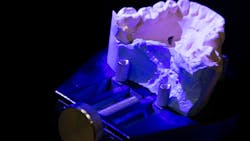Want to ‘play video games for a living’? Check out CAD/CAM
If you’re reading this, congratulations. You’re probably in the elite group of dentists who understand the power and potential of digital dentistry and CAD/CAM. To use a euphemism from generation X, have you unlocked the secret codes yet, or have you stopped at level one and are simply making crowns all day? If you’ve made it this far, perhaps you’re willing to come a little farther. Just like with any video game that’s been released since the ‘80s, there’s a world of gems hidden in the depths. The only thing standing between you and the treasure is a little extra training. Read on to see what true CAD/CAM “gamers” know.
Crowns are the icing on the cake. There are continuing education classes for elevated CAD/CAM procedures throughout the country, but the real fun is in the networking. There are so many websites and social media pages where you can ask questions, seek council, and show your favorite or most difficult cases to the community and make the group better as a whole. We’ve seen these platforms build reputations, spawn alternate career trajectories, and build legends of CAD/CAM folklore. I’d argue there has never been a better time to be a dentist, and CAD/CAM dentists have more fun.
Where to start
While the early training typically introduces new users to posterior crowns because they’re one of the most prevalent and basic cases. Anterior crowns require an elevated level of skill and practice. They’re hard even for a lab to do, although some of that is from never actually seeing the patient face to face, and the shading is left up to a third party (you). However, anterior crowns are a great skill to master as it seems that many of those “weekend accident” calls you get from your favorite patients on a Friday night or Saturday require just that. Anterior crowns are what most people need quickly.
Orthodontics is another excellent field for CAD/CAM users. Digital scanning improves orthodontic accuracy, and scanning has never been easier or more intuitive. In fact, artificial intelligence in orthodontic software is now recommending courses of treatment based on the scans. As with anything else, improved accuracy brings greater efficiency. Ortho patients whose dentists use CAD/CAM can anticipate fewer visits and shorter treatment plans. In fact, a 2015 study in the American Journal of Orthodontics and Dentofacial Orthopedics highlighted some facts about CAD/CAM orthodontic appliances compared to standard treatments. While there was no statistical difference in the results for patients, the treatment times and number of visits were significantly fewer for CAD/CAM appliance users than for patients using standard (bonding) treatments. Users are not limited to retainers, either. They can also print mouth guards and 3D study models.
Implants and bridges are greatly improved with the use of CAD/CAM technology. Implants require intense technical skill in general, but CAD/CAM can take some of that edge off the user, especially when aided by the integration of 3D/CBCT technology. Procuring all the necessary materials yourself (surgical guides, abutments, implants, etc.) also cuts down on expenses by eliminating lab fees and supply markup costs. Another factor that should not go unmentioned is that CBCT could soon become a primary tool for diagnosing sleep disorders. Between this and the fact that 3D technology increases otherwise undetectable findings, the integration factor is hard to overlook as a tool for practice growth. Local distributors often offer one-day trainings that not only put you on the path to building a good understanding of the procedure but can build your local network. I cannot stress enough the importance of using your network as a means of support. Practicing new procedures can be daunting when done alone, but knowing you are an email or phone call away from a second opinion can remove the stress.
A newer field of study for dental practitioners is sleep disorders. Digital dentistry is an integral part of efficient sleep disorder treatment, and with the integration of 3D printing, an exponentially more profitable one. According to the American Academy of Sleep Medicine, about 40% of adult men and almost 25% of adult women are habitual snorers. This is a field where the integration of 3D/CBCT technology boosts incidental findings and diagnoses, so it is worth noting. Typically, those using CAD scanners alone send scans to a third party to have devices created. Regardless of integration with 3D scanning or 3D printing, the statistics on sleep disorders and undiagnosed cases make this a lucrative focus for any dental practice.
A less-clinical focus for elevated CAD/CAM users is education. There is always demand for key opinion leaders (KOLs). People who have experienced these specialties can speak about the changes associated with each and can find teaching opportunities nationwide. Social media pages are full of CAD/CAM experts discussing the newest technologies, products, and procedures. Doctors for training are required for new users and local events, As an outside observer who’s asked many of the questions, it seems like a fun way to take a break from daily practice, although most of them assure me that CAD/CAM dentistry is anything but monotonous. One even started a lecture with, “I play video games for a living,” (referring to digital scanning). You can’t beat that enthusiasm.
CAD/CAM goes way beyond the simple posterior crown procedure that all dentists are taught at the onset of their journey. While CAD/CAM pays for itself with just the basics, imagine days filled with varying case complexity, exciting collaboration, and an office staff eager for the day’s procedures. If that and what I’ve discussed here aren’t enough to show that CAD/CAM is the center of the dental universe, I don’t know what is.
MATTHEW NEWMAN is the Director of Sales Operations, Marketing and Public Relations for CAD-Ray North America. a distributor of practical CAD/CAM solutions and home of the Medit intraoral scanner. A 20-plus year veteran of operational management, he has spent his career in the fields of dental B2B, operations management, and hospitality. Newman writes articles about operational management, office synergy, startups, and a variety of other topics. He can be reached through direct message on LinkedIn.
About the Author

Matthew Newman
Matthew Newman is the VP of sales operations, marketing and public relations for CAD-Ray North America. a distributor of practical CAD/CAM solutions, and home of the Medit intraoral scanner. A 20-plus year veteran of operational management, he has spent his career in the fields of dental B2B, operations management, and hospitality. Newman writes articles about operational management, office synergy, startups, and a variety of other topics. He can be reached through direct message on LinkedIn.
Updated December 15, 2024
